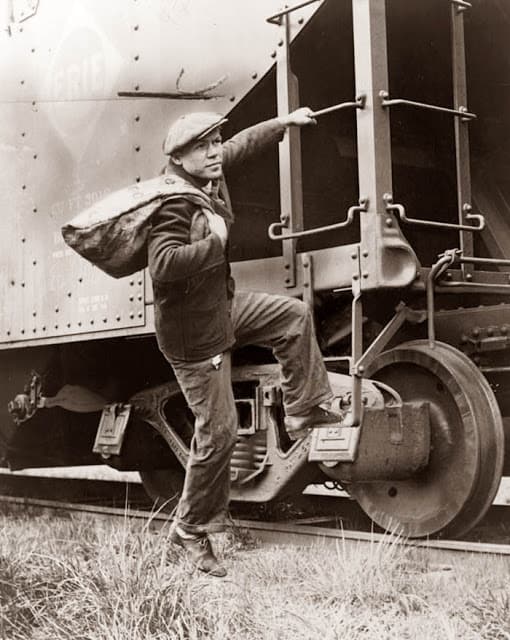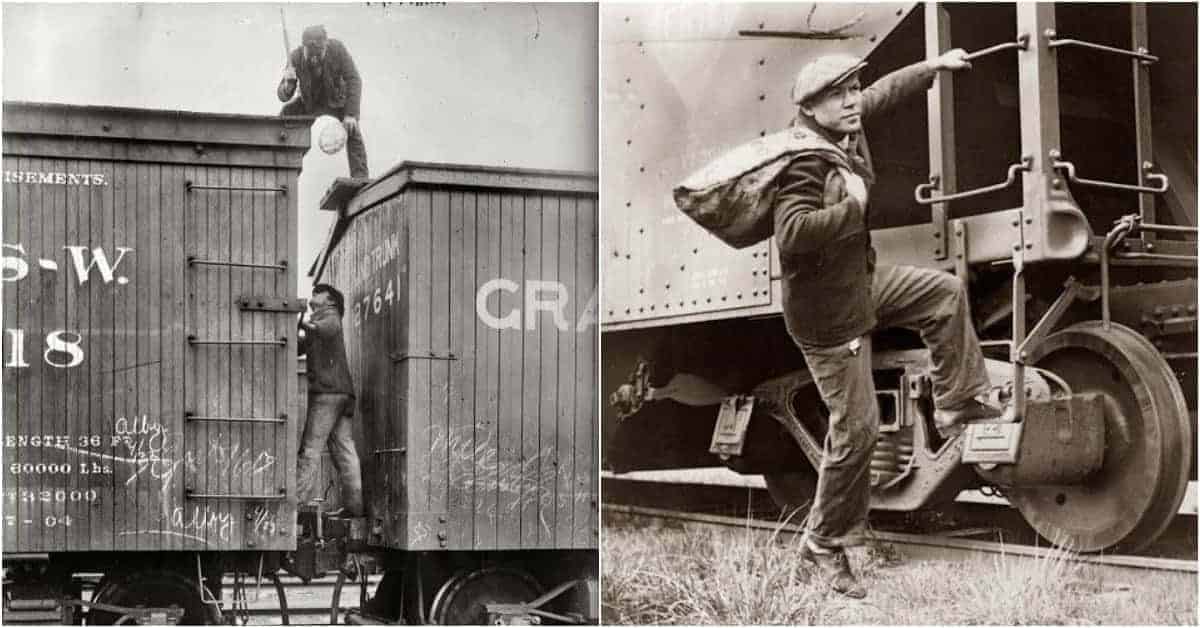A hobo is a migrant worker or homeless vagabond. The term originated in the United States around 1890. Hobos, unlike ‘tramps’ or ‘bums,’ are traveling workers. The etymology of the term ‘hobo’ is unknown but it is believed that it could be derived from ‘hoe-boy’ meaning ‘farmhand’ or from a greeting like “Ho, boy!” Other possibilities are that it comes from the railroad greeting “Ho, beau!” or that it is an abbreviation of ‘homeword bound’ or ‘homeless boy.’
It is believed that the early hobos came into existence as a result of the end of the Civil War with many veterans hopping freight trains home. Men also hopped trains heading west to look for work. By 1906 there were roughly half a million hobos in America (.6% of the population at the time) and by 1911 there were 700,000. The Great Depression also resulted in a large increase in hobos.
Life as a hobo was difficult. The travelers were poor, hungry, and faced hostility from train crews and railroad security staff known as ‘bulls.’ Hopping on and off moving trains was also very dangerous. It was easy to get trapped between cars, and in bad weather, it was entirely possible to freeze to death.
Jeff Davis, in the early 1900s, was known as the King of the Hobos. He believed in fostering self-sufficiency among the men. In 1913, Davis opened the first Hotel de Gink in Seattle, a self-sufficient shelter where the men would cook, barber, tailor, and provide basic medical care for each other. Residents were expected to volunteer at the hotel for at least two days per week in exchange for lodging. The concept of these hotels spread across the country and by 1915, Davis opened a Hotel de Gink in New York City.
An ethical code was created by Tourist Union #63 during its 1889 National Hobo Convention in St. Louis Missouri. This code was voted upon as a concrete set of laws to govern the Nation-wide Hobo Body; it reads this way:
- Decide your own life, don’t let another person run or rule you.
- When in town, always respect the local law and officials, and try to be a gentleman at all times.
- Don’t take advantage of someone who is in a vulnerable situation, locals or other hobos.
- Always try to find work, even if temporary, and always seek out jobs nobody wants. By doing so you not only help a business along, but ensure employment should you return to that town again.
- When no employment is available, make your own work by using your added talents at crafts.
- Do not allow yourself to become a stupid drunk and set a bad example for locals’ treatment of other hobos.
- When jungling in town, respect handouts, do not wear them out, another hobo will be coming along who will need them as badly, if not worse than you.
- Always respect nature, do not leave garbage where you are jungling.
- If in a community jungle, always pitch in and help.
- Try to stay clean, and boil up wherever possible.
- When traveling, ride your train respectfully, take no personal chances, cause no problems with the operating crew or host railroad, act like an extra crew member.
- Do not cause problems in a train yard, another hobo will be coming along who will need passage through that yard.
- Do not allow other hobos to molest children, expose all molesters to authorities, they are the worst garbage to infest any society.
- Help all runaway children, and try to induce them to return home.
- Help your fellow hobos whenever and wherever needed, you may need their help someday.
- If present at a hobo court and you have testimony, give it. Whether for or against the accused, your voice counts!




― Jack London, The Road by Jack London, Fiction, Action & Adventure. Wikimedia Commons
















